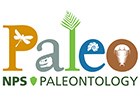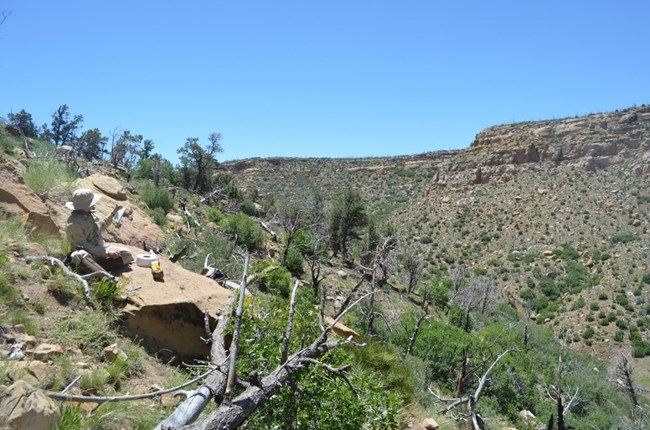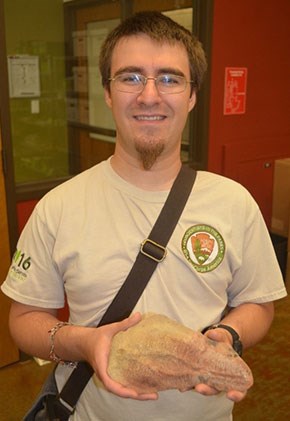Part of a series of articles titled Park Paleontology News - Vol. 10, No. 2, Fall 2018.
Article
Fossil Shark Egg Case Discovered at Mesa Verde National Park

Article by G. William M. Harrison, GIP Paleontology Intern, Mesa Verde NP
for Park Paleontology Newsletter, Fall 2018

NPS Photo
Known for its archeological wonders, Mesa Verde National Park is also a nearly untouched treasure trove of Cretaceous fossil material. The spectacular Ancestral Puebloan buildings are chiseled within alcoves in the fossiliferous Cliff House Sandstone. Deposited in a shallow continental seaway, these rocks contain fossil fish, shark, and marine reptile teeth as well as ammonites, bivalves, rare sea reeds, and driftwood fragments. Despite these very productive rocks, Mesa Verde National Park’s paleontology is barely studied. Several expeditions were mounted during the late 1970s and early 1980s, but most collecting was done by amateurs from the 1930s to the 1990s and a talented retiree who was active in the 1980s and 1990s. As a result, the precision and accuracy of identifications and provenance information varies wildly for the specimens in the collections.
This combination of factors drew me to Mesa Verde National Park. In 2015 and 2017, the Geoscientists-in-the-Parks program funded internships for me to assist in collections and field work at Mesa Verde. One of my primary tasks was unearthing old records and scouring the back country for sites described therein in order to restore usable provenance data to old fossil sites. The other position focused on reviewing and photographing the collections.

NPS Photo
Exploring a dissected mesa in the high desert can be difficult work. Trails up and down the canyons are sparse and infrequently maintained, often turning hikes that are 1 km as the crow flies into 8 km as the geologist trudges. On one occasion, I assisted vegetation management crews with a rare plant survey before being set free to wander. During that excursion, one of the vegetation crew shouted “Hey! I found a fossil leaf!” Upon examination, I knew that the rock was not a leaf. My Cincinnatian mind immediately thought of Rusophycus, the trilobite resting trace. While a good match for its shape, trilobites went extinct nearly 170 million years before the Cliff House Sandstone was deposited. Stumped, I did extensive research, focusing mainly on trace fossils in the hopes of finding a Mesozoic equivalent. I was about to give up and consign it to the realm of “unknown trace fossil or odd sedimentary feature” when I made a new discovery. Hidden deep in the collections, there was another of these fossils. Also identified as a leaf, it was found in similar strata elsewhere in the park. This discovery bolstered my efforts and I consulted experts until one of them was able to identify it as a fossilized chimaera egg case.
Chimaeras are a kind of cartilaginous fish, sometimes known as “ghost sharks” or “rat fish”. They are distant cousins of sharks and have existed for more than 400 million years. Chimaera eggs are extremely rare in the fossil record and not only because they are often misidentified as leaves. Being made of collagen, they have none of the mineralized hard parts that comprise much of the fossil record. Additionally, modern chimaeras prefer to lay their eggs in shallow nursery environments, avoiding the anoxic conditions which facilitate soft body fossilization. The discovery of two fossil chimaera eggs at different sites in the same general area is unprecedented.
These finds, one from the field and one from the collections, highlight the need for more work studying Mesa Verde’s paleontological resources. The Cliff House Formation of Mesa Verde is already home to a remarkably well preserved starfish impression and has great potential for spectacular finds, while the underlying Menefee Formation has produced an undescribed species of poppy flowers and many remarkably preserved tree leaves, some of which may be new species. Who knows what future studies will find?
Related Links
- Mesa Verde National Park, Colorado—[Geodiversity Atlas] [Park Home]
- NPS—Fossils and Paleontology
- National Fossil Day Partnership
- NPS—Geology
Last updated: May 10, 2019
